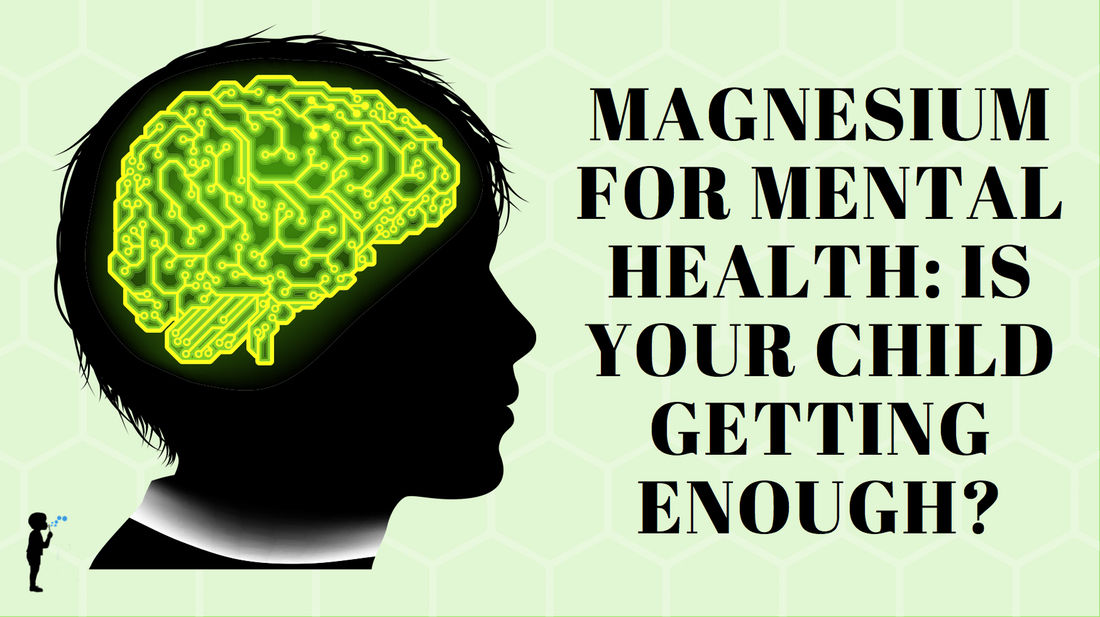
Magnesium for mental health: is your child getting enough?
Magnesium is an important mineral for children’s overall health. It’s involved in over 300 types of reactions in the body including energy production, regulating the functions of the muscles, nerves and heart, regulating blood pressure and blood sugar, and helping to maintain a healthy immune system. (Yes, it’s that important!)
Unfortunately, between two and fifteen percent of the general US population has a magnesium deficiency, and only about a third of Americans are consuming the recommended daily intake. With nine out of ten kids not eating enough vegetables, it’s not surprising that they may not be getting enough magnesium in their diets. Diets containing empty calories from processed foods, sugary drinks and sodas can contribute to not getting enough magnesium from the diet.
The most common symptoms of magnesium deficiency include:
- Agitation
- Anxiety
- Confusion
- Fatigue
- Headaches
- Heart rhythm abnormalities
- Insomnia and sleep disorders
- Irritability
- Loss of appetite
- Muscle spasms and weakness
- Nausea and vomiting
- Personality changes
- Poor nail growth
- Restless leg syndrome
How much magnesium does your child need?
The Food and Nutrition Board at the Institute of Medicine sets the recommended dietary allowances for magnesium, which is the level considered to be sufficient for most healthy individuals. Here’s what they recommend:
- 0-6 months: 30 mg (this level is considered to be an adequate intake)
- 7-12 months: 75 mg (this level is considered to be an adequate intake)
- 1-3 years: 80 mg
- 4-8 years 130 mg
- 9-13 years: 240 mg
- 14-18 years, female: 360 mg
- 14-18 years, male: 410 mg
Children who are experiencing health concerns or taking medications, may have a higher need for magnesium.
Magnesium’s Role in Mental Health
Magnesium seems to play a few valuable roles in mental health by affecting various brain signaling chemicals known as neurotransmitters. Magnesium also plays a role in nerve functioning and supporting a healthy mood. A few of the ways that magnesium contributes to mental wellness are outlined below.
Stress and anxiety and mood
There is a link between magnesium deficiency and stress. People with less magnesium tend to have more negative stress symptoms. When stress increases – whether it’s physical or emotional stress – so does the body’s need for magnesium. In people living with chronic stress, low magnesium has been linked to an increased stress response.
Researchers think that magnesium reduces the activity of stress hormone related systems in the body, which might explain some of its calming effects. One study in particular looked into the effects of magnesium in students during exam periods. The students were found to have increased anxiety during exams, which was related to a reduction in magnesium by the body – this suggests that there is a greater need for magnesium during stressful situations. Clinically, I’ve found magnesium to be very helpful in treating children who are experiencing anxiety and elevated stress.
Early research is showing magnesium to be beneficial in the treatment of tension headaches in children, which isn’t surprising considering its ability to reduce stress hormones in addition to its role in muscle relaxation.
Magnesium has also been show to be helpful for depression. Inadequate magnesium seems to contribute to depression by reducing serotonin levels, the brain’s key natural antidepressant.
Attention, concentration and learning
Magnesium deficiency has been linked to anxious restlessness, fidgeting and learning disabilities in children. Deficiency was also found to be more frequent in children with Attention Deficit Hyperactivity Disorder (ADHD) than children without ADHD. The use of daily magnesium supplements resulted in a significant decrease in hyperactivity compared to kids who weren’t treated with magnesium. More studies have shown improvements in behaviors with vitamin B6 and magnesium supplementation. Magnesium also seems to enhance learning and memory in animal studies, but human studies are needed.
Sleep
Magnesium seems to play a role in sleep quality in human and animal studies, and a magnesium deficient diet has been linked to reduced sleep quality. In newborn infants, magnesium increased the length of deep sleep; in young and older adults it is known to positively effect sleep, including restorative sleep. How many of us wouldn’t benefit from more restful sleep!?!
One of the safest ways to obtain magnesium is through the diet. Legumes, nuts, seeds and grains are some of the richest sources of magnesium.
Here are a few of the best food sources of magnesium:
| Beans and Legumes (cooked) | Serving Size | Magnesium in mg * |
| black beans | ½ cup | 60 |
| edamame (steamed green soy beans) | 1/2 cup | 54 |
| green peas | 1/2 cup | 28 |
| kidney beans | 1/2 cup | 37 |
| lentils | 1/2 cup | 35 |
| lima beans (also known as butter beans) | 1/2 cup | 40 |
| navy beans | 1/2 cup | 48 |
| pinto beans | 1/2 cup | 42 |
| Nuts and Seeds | Serving Size | Magnesium in mg * |
| almonds, dry roasted | 1/4 cup | 96 |
| almond butter | 1 tbsp | 45 |
| brazil nuts, whole | 1/4 cup | 125 |
| cashews | 1 oz | 83 |
| cashew butter | 1 tbsp | 41 |
| chia seeds | 1 oz | 95 |
| flax seeds whole/ground | 1 tbsp | 40 |
| hemp seeds, shelled | 1 tbsp | 70 |
| peanuts, dry roasted | 1/4 cup | 65 |
| pistachios, roasted | 1/4 cup | 33 |
| pumpkin seeds (shells removed) | 1/4 cup | 191 |
| pumpkin seeds (shells removed), roasted | 1/4 cup | 162 |
| sesame seeds, toasted | 1 oz | 101 |
| sunflower Seeds | 1/4 cup | 113 |
| walnuts, raw | 1 oz | 42 |
| Grains (cooked) | Serving Size | Magnesium in mg * |
| amaranth | 1/2 cup | 80 |
| brown rice | 1/2 cup | 43 |
| buckwheat | 1/3 cup | 29 |
| millet | 1/2 cup | 38 |
| oats | 1/2 cup | 32 |
| quinoa | 1/2 cup | 59 |
| Vegetables and Fruit | Serving Size | Magnesium in mg * |
| banana, mashed | 1/2 cup | 30 |
| collard greens, cooked | 1/2 cup | 20 |
| spinach, steamed or boiled | 1/2 cup | 78 |
| squash, butternut, cooked | 1 cup | 59 |
| squash, acorn, cooked | 1 cup | 88 |
| swiss chard | 1/2 cup | 75 |
| Meats, fish and poultry | Serving Size | Magnesium in mg * |
| beef, extra lean ground, cooked | 3 oz | 20 |
| tuna | 4 oz | 47 |
| turkey breast, cooked | 1 oz | 27 |
| Other | Serving Size | Magnesium in mg * |
| molasses | 1 tbsp 1 tsp |
48
16 |
* Levels are approximate and adapted from the USDA’s National Nutrient Database for Standard Reference Release 28.
Many cereals, whole grain products, milk alternatives (soy milk, almond milk, etc) and fortified yogurts are sources of magnesium. Refer to the product labels to find out how much magnesium they contain.
Dealing with a picky eater or little food connoisseur? No worries – you can sneak magnesium rich foods into meals that they already love!
Here are a few tips:
- Choose products made with whole grains over those made with refined white flour. When grains are overly processed, a lot of the key nutrients, including magnesium, are lost.
- Thicken soups, sauces and stews with cooked and pureed beans, or red lentils (which dissolve when well cooked and lend a hearty texture).
- Puree lima beans – known as butter beans for their buttery texture – with a bit of butter, salt and water to thin the puree if needed. They’re as yummy as mashed potatoes but packed with more protein, fibre and magnesium.
- Sneak in steamed leafy greens like spinach and collard greens by them to soups and sauces. Chop, mince or puree them first – depending what type of texture connoisseur your child is. Pureed greens can be made ahead and frozen for future use.
- Add mashed or pureed beans into homemade burgers and meatballs, or any beef based dishes.
- Serve nuts and seeds as snacks. If your child’s school doesn’t allow nuts for safety reasons, most schools will allow seeds instead. Click here for my recipe for homemade sesame snaps.
- Use nut butter as a spread on crackers, toast or bread.
- Use molasses as a sweetener for baked goods.
- This tasty maple cinnamon pepita (pumpkin seed) recipe makes a quick and tasty treat – and it’s kid tested and approved.
Before making any changes:
This article is intended for educational purposes only, and is not intended to diagnose or treat your child. If your child has any medical conditions or food allergies, please consult a naturopathic doctor prior to making any dietary changes – a customized approach to treatment is always best. Do NOT give your child any nutritional supplements without consulting a naturopathic doctor or other licensed healthcare professional first.
Further Reading:
If your child is dealing with stress or anxiety, check out this article to learn about 8 naturopathic approaches to addressing your child’s anxiety, and to learn more about when it’s time to seek professional help.
Looking for more dietary tips to address your child’s behavior? One of the most important things you can do is to help your child optimize their blood sugar control. Check out this great article on how to improve your child’s behavior with blood sugar control by Dr. Maggie Luther, ND.
References
Agricultural Research Service. 2004. “Lack Energy? Maybe It’s Your Magnesium Level.” Science Daily, USDA.
Ayuk J, Gittoes NJ. 2014. “Contemporary view of the clinical relevance of magnesium homeostasis”. Annals of Clinical Biochemistry. 51 (2): 179–88
Behnood A, Masud K, Khosro S, Minoo M, Shirazi MH, Bahram R. 2012. The effect of magnesium supplementation on primary insomnia in elderly: a double blind placebo-controlled clinical trial Journal of Research in Medical Sciences. Dec 2012: 1161-1169
Carol B, Kuester, S, Gillespie C. 2000. Beverage Choices Affect Adequacy of Children’s Nutrient Intakes. Arch Pediatr Adolesc Med 154(11):1148-1152.
Centre for Disease Control. 2014. Children eating more fruit, but fruit and vegetable intake still too low. Vital Signs Report. National Health and Nutrition Examination Survey 2003 to 2010.
Cernak I, Savic V et al. 2000. Alterations in magnesium and oxidative status during chronic emotional stress. Magnesium Research 13(1): 29-36.
Depoortere H. Françon D. Llopis J. 1993. Effects of a Magnesium Deficient Diet on Sleep Organization in Rats. Neuropsychobiology 27: 237–245.
Dralle, D. Bodeker, RH. 1980. Serum magnesium level and sleep behavior of newborn infants. European Journal of Pediatrics 134(3): 239–243.
Eby GA, Eby KL. 2010. Magnesium for treatment-resistant depression: a review and hypothesis. Med Hypothesis 74(4):649-60.
Ford ES, Mokdad AH. 2003. Dietary magnesium intake in a national sample of U.S. adults. J Nutr. 133(9): 2879-82.
Fox C, Ramsoomair D, Carter C. 2002. Magnesium: its proven and potential clinical significance. South Med J 94(12) :1195-1201.
Grases G et al. 2006. Anxiety and stress among science students. Study of calcium and magnesium alterations. Magensium research 19(2): 102-6.
Grazzi L, Andrasik F, Usai S, Bussone G. 2005. Magnesium as a treatment for paediatric tension-type headache: a clinical replication series. Neurological Sciences 25(6): 338-341.
Findling, RL, Maxwell K, Scotese-Wojtila L et al. 1997. High-Dose Pyridoxine and Magnesium Administration in Children with Autistic Disorder: An Absence of Salutary Effects in a Double-Blind, Placebo-Controlled Study. J Autism Dev Disord 27: 467
Guerrera, MP, Volpe SL, Mao, JJ. 2009. Therapeutic Uses of Magnesium. American Family Physician 80(2): 157-162.
Institute of Medicine Food and Nutrition Board. 1997. Dietary Reference Intakes: Calcium, Phosphorus, Magnesium, Vitamin D and Fluoride. Washington, DC: National Academy Press.
Institute of Medicine Food and Nutrition Board. 2004. Dietary Reference Intakes: Calcium, Phosphorus, Magnesium, Vitamin D and Fluoride. National Academy Press. Washington, DC.
Kozielec T, Starobrat-Hermelin B. 1997. Assessment of magnesium levels in children with attention deficit hyperactivity disorder (ADHD). Magnesium Research 10(2):143-148.
Levy SE, Hyman SL. 2008. Complementary and alternative medicine treatments for children with autism spectrum disorders. Child Adolesc Psychiatric Clin N Am 17(4):803-820.
Mousain-Bosc M et al. 2004. Magnesium Vit B6 Intake Reduces Central Nervous System Hyperexcitability in Children. Journal Of The American College Of Nutrition Vol. 23(5).
Mousain-Bosch M. et al. 2006. Improvement of neurobehavioral disorders in children supplemented with magnesium-vitamin B6. Magnesium research 19(1): 53-62.
Starobrat-Hermelin B, Kozielec T. 1997. The effects of magnesium physiological supplementation on hyperactivity in children with attention deficit hyperactivity disorder (ADHD). Positive response to magnesium oral loading test. Magnesium research 10(2): 149-156.
United States Department of Agriculture. Agricultural Research Service. National Nutrient Database for Standard Reference Release 28. Accessed online August 31, 2016: https://ndb.nal.usda.gov/ndb/nutrients/report/nutrientsfrm?max=25&offset=0&totCount=0&nutrient1=304&nutrient2=&nutrient3=&subset=0&fg=&sort=f&measureby=m.
Wein, H. 2013. Where Kids Get Their Empty Calories. NIH Research Matters – National Institutes of Health. U.S National Library of Medicine Web. 11 Mar. 2013. http://www.nih.gov/researchmatters/
World’s Healthiest Foods. 2016. Magnesium. Accessed online August 30, 2016: http://www.whfoods.com/genpage.php?tname=nutrient&dbid=75#foodchart



Tanya
January 21, 2017 at 11:19 amI have a question about frankincense my husband and I have used this as a pain management for years 20%frankinsense 80% grape seed oil is this a health risk?